In the case of particularly beautiful roses, it is worth increasing them. We show you how to easily propagate roses with seeds, cuttings and the like.
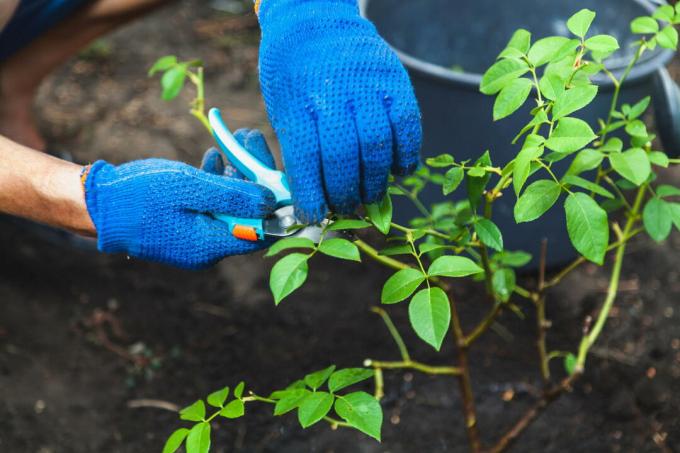
If you've always wondered if you can Rose bushes (pink) for the garden can also be propagated from cut roses, then you have come to the right place. But maybe you've heard of it before that you can put roses on potatoes (Solanum tuberosum) can and now want to dare to try this unusual experiment themselves. In addition to these unusual forms of reproduction of roses, we will also introduce you to the common methods of propagation using seeds, cuttings and sinkers. In this article, we will explain to you how best to proceed with the propagation of individual rose varieties and what to watch out for.
contents
- Propagate roses by seeds
- Propagate roses by cuttings
- Propagate roses with cuttings
-
Increase roses through grafting
- Refine rose on potato
- Increase the rose by lowering it
There are several ways in which you can propagate roses yourself. In the following, we explain some methods for multiplying your favorite rose using cuttings, sinkers, etc. An overview article with interesting information on the subject Roses You will find here.
Propagate roses by seeds
Propagation via seeds from the rose fruits (rosehips) is not only suitable for Wild roses, for... As well Noble- and Shrub roses as well as for rambler varieties. However, hybrid varieties are not suitable for seed propagation, because this is where Splitting of the genetic material, as a result of which the varietal characteristics are not preserved in the progeny can be.
In autumn, collect the ripe rose hips and carefully remove the seeds. The best way to do this is to cut the fruit with a sharp knife and scrape out the pulp with the seeds. Then put this in a sieve and clean the seeds under running water until they are completely clean of the pulp.

However, seeds that thrive inside a fruit are naturally endowed with sprout inhibition. To break this, you can soak the rose seeds in a thermos with lukewarm chamomile tea for about 48 hours. In order for the seeds to finally get into the germination mood, a cold stimulus is also necessary. This process is also known as stratification. To do this, store the rose seeds in moist sand for a few weeks in the refrigerator at around 4 to 5 ° C.
The pre-treated seeds from home-grown can be planted as soon as they start to sprout. Stratified seeds from specialist shops can be sown immediately. For sowing, fill some seed trays with potting soil. For example, the Plantura organic herb & seed compost outstanding. Insert the rose seeds about an inch deep enough away from them. Always keep the soil moist for the next few days to weeks. When small seedlings have grown from the seeds, place the bowl in a bright, not too warm place without direct sunlight. After the cotyledons, the first real leaves are formed. Then it is time to plant the little rose plants in pots with nutrient-rich garden soil. In spring, when no more frost is expected, you can then transplant the rose plants to their destination in the garden.
Tip from the professional: Whenever you propagate roses from seeds, you should always prepare sufficient rose seeds to increase your chances of growing success. Because not all seeds can germinate and actually grow into a new rose plant.
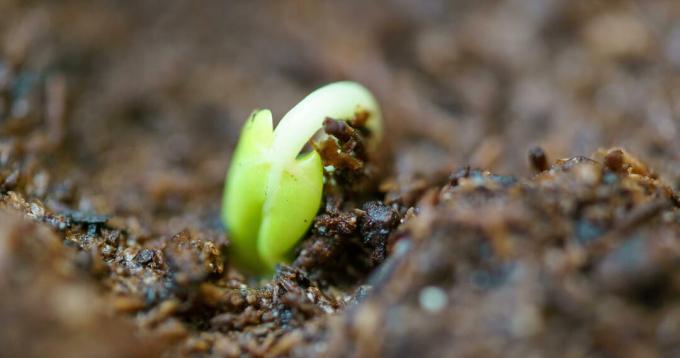
Propagate roses by cuttings
The simplest and most efficient method is probably the propagation via cuttings. To do this, cut about three cuttings in late summer (August), depending on what you want varietyto increase the success rate. It is best to use shoots that have just faded and shorten them to about 15 to 20 centimeters in length. In the best case, the cuttings should have at least five eyes. Make sure to use sharp tools for cuttings and make the cut on the underside at an angle to make it easier for the cuttings to absorb water.
Except for the top pair of leaves, all leaves can now be removed in order to keep the evaporation rate as low as possible. Then fill small pots with potting soil or slightly sandy garden soil and insert the prepared shoot pieces about halfway into them. Water the cuttings well and place them in a warm, bright place. For optimal greenhouse conditions, you can cut off the bottom of a plastic bottle and place it over the cutting. But don't forget to ventilate from time to time to avoid mold growth. After the first new leaves have developed, they should also be removed again. In addition, do not forget to regularly water the planted cuttings. In the following spring (May) the rooted young roses can then be planted at their destination.
Thanks to the vase method, you can also grow small rose bushes from cut roses. To propagate the roses in the water, you should first remove the withered flowers. Then put the rose stems in a glass vase with lukewarm water. A warm, bright location without direct sunlight is ideal. Now you should change the water daily until the rose forms roots and can be transplanted into a pot of soil.
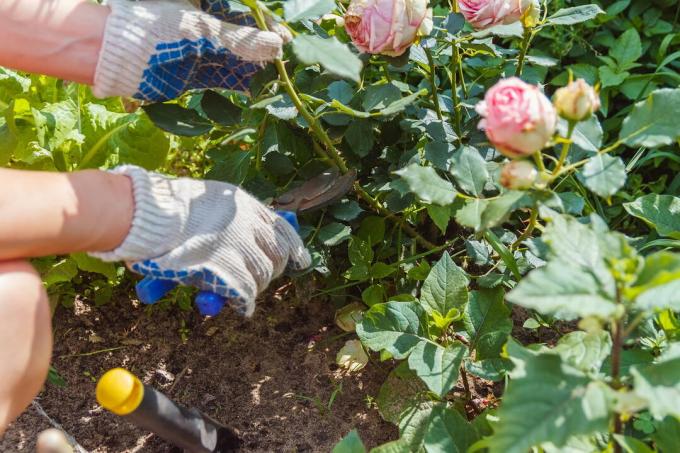
Tip from the professional: Propagation via cuttings produces true-root roses, but some roses do not root very well as cuttings and are therefore propagated through grafting. Roses that are under plant variety protection, on the other hand, are not allowed to be propagated using cuttings in the first place.
Propagate roses with cuttings
Another form of vegetative propagation takes place through cuttings. In contrast to the cuttings, these are not cut in summer, but in late autumn or winter. To do this, separate lignified rose shoots after the leaves have fallen and shorten them to a length of around 20 to 30 centimeters. Then all side shoots and leaves are removed. Now fill a lockable box with damp sand. This is where the cuttings are stored in bundles so that they do not dry out until they are planted out. It is best to place the box in a cool, frost-free room over the winter months. When strong frosts are no longer expected in spring (March) and it is slowly warming up again, plant the cuttings in potting soil - for example the Plantura organic herb & seed compost - or a mixture of sand and peat. In autumn of the same year you can then plant the rooted cuttings with the first green leaves at their destination.
Tip from the professional:Bedding and Hybrid Tea Roses cannot be propagated particularly well using cuttings, as they lack the necessary growth and root strength for this.
Increase roses through grafting
Garden professionals can multiply their roses by grafting them. This type of reproduction is common practice among rose growers. A possible and popular form of refinement is the ooculation. An eye of a hybrid tea rose is inserted into the root neck of a wild rose, which serves as a base. The robust, strong-growing wild rose later supplies the hybrid tea, which can develop so well and produce many beautiful flowers. For this method to be successful, expertise, practice and the right tools are essential. To make the cut as smooth as possible, you need a very sharp knife or a special grafting knife.
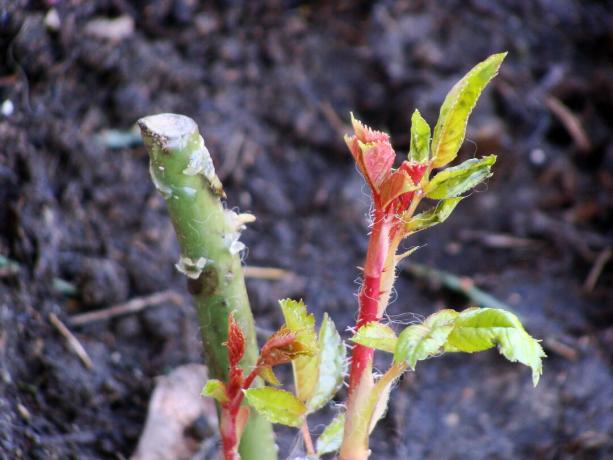
Grafting can begin on a hot summer day in July, when the rose is fully in its sap. To do this, first make a T-cut on the root neck of the wildling. Then cut a piece of bark from the hybrid tea with only one bud and about two centimeters long. Carefully peel off the bark around the T-cut and slide the bud into the opened cut. In order to protect the wound, it is best to carefully bandage it with raffia. In the following spring, the upper part of the wild rose above the T-cut is removed so that the noble bud is forced to sprout from the base. In June, remove the tip of the noble shoot so that the rose has multiple shoots. Incidentally, the process of inoculation is also carried out when growing tree roses.
Another well-known form of refinement is grafting. While only a single eye is transplanted into the base when grafting, a whole shoot is transplanted when grafting. This propagation technique is often used for fruit trees, which are also part of the rose family (Rosaceae) counting. More interesting information about the vegetative reproduction different types of plants can be found here.
Refine rose on potato
It is often recommended that cut roses be rooted in a vase with lukewarm water and planted later. However, this form of propagation is not very promising and therefore not recommended. Roses on potatoes - that sounds a bit unusual, especially when you consider that these two plants belong to completely different families. From a potato and a cut rose given for free, whose blossoms usually only last a short time Is permanent, however, you can grow a rose plant that will thrive in the garden for many years to come can. As Propagate roses with a potato we explain in detail in our special article.
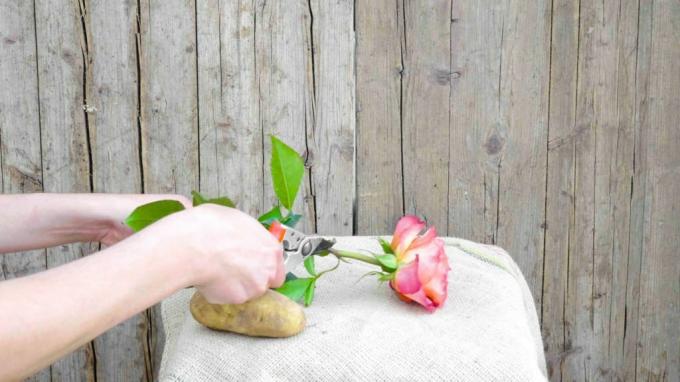
Increase the rose by lowering it
Some roses can also be propagated wonderfully with lowerers. Shrub, Rambler or Climbing roses are particularly suitable for this, as their long shoots are easy to bend. In late summer after flowering, choose a long shoot that bends down easily. You can also carefully cut woody shoots so that they do not break. Place the shoot in a hollow about eight inches deep and cover the middle part with a mixture of soil and compost. You can also fix the shoots that keep bending upwards with a branch fork that you stick in the ground. In the following weeks, the soil must be kept well moist. From autumn onwards, new roots emerge at the branch curvature. In the following spring, when the new rose plant is rooted strong enough to grow into care, it can be separated from the mother plant and planted at its final destination will.
